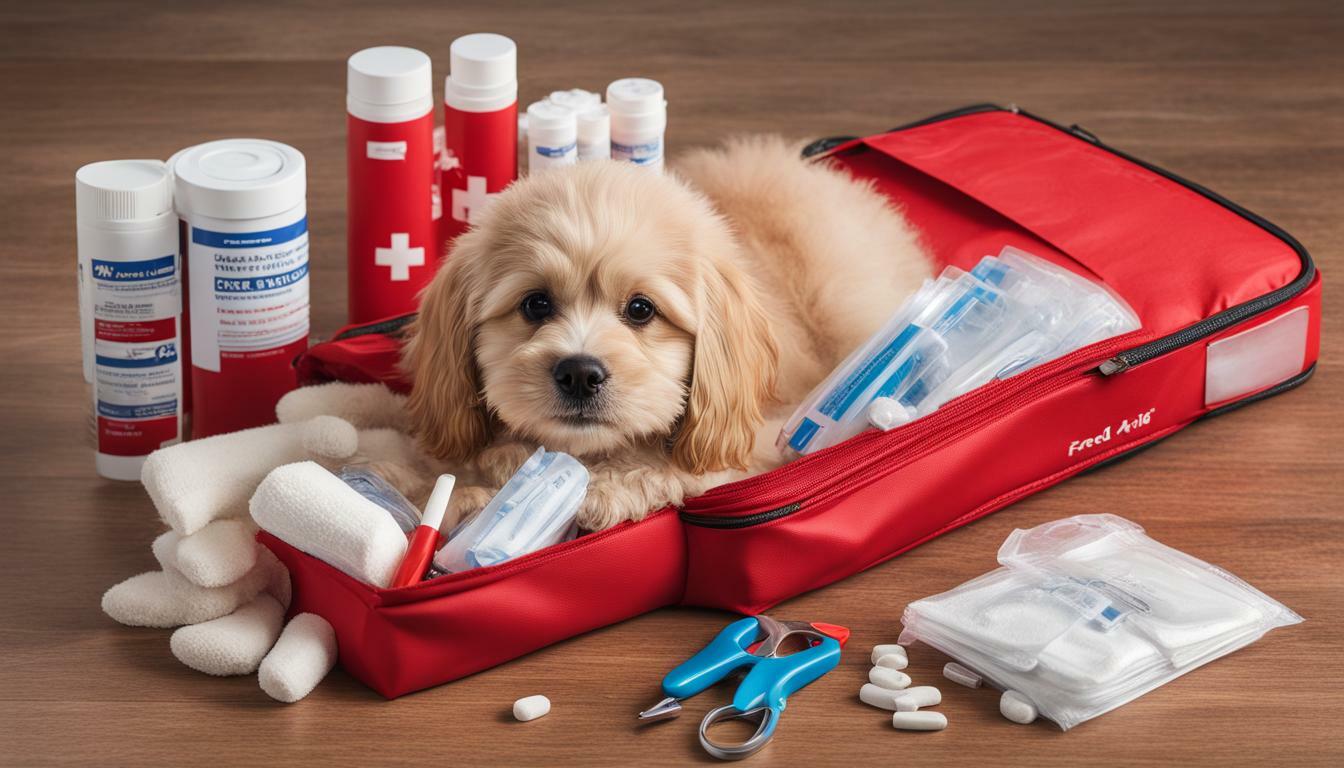As a pet owner, keeping your furry friend safe and healthy is a top priority. Accidents and emergencies can happen at any time, and having a first aid kit for your pet can make all the difference in an emergency situation. A well-stocked first aid kit can help you address common animal emergencies and provide immediate care to your pet.
There are several things to consider when putting together a pet first aid kit. It’s important to include essential items such as bandages, antiseptics, and medications. You should also have a basic understanding of common pet medical emergencies, such as choking, wounds, burns, and poisoning. By being prepared and knowledgeable, you can act quickly and effectively in providing emergency care for your pet.
Key Takeaways
- A first aid kit for pet owners is vital in addressing common animal emergencies.
- Essential items such as bandages, antiseptics, and medications should be included in a pet first aid kit.
- Familiarize yourself with common pet medical emergencies to act quickly and effectively in providing emergency care for your pet.
Understanding Pet Medical Emergencies
As a responsible pet owner, it is crucial to be aware of the potential medical emergencies that your pet may face. Knowing how to recognize and address these emergencies can make all the difference in ensuring the health and safety of your furry friend. Here are some common pet medical emergencies to be aware of:
| Pet Medical Emergencies | Symptoms | Emergency Care |
|---|---|---|
| Choking | Coughing, gagging, pawing at mouth | Perform the Heimlich maneuver or remove object with pliers |
| Wounds | Bleeding, swelling, discharge | Clean wound, apply pressure, and wrap with bandages |
| Burns | Redness, swelling, blisters | Cool the burn with water, apply aloe vera or antibiotic ointment, and cover with a non-stick wrap |
| Poisoning | Vomiting, diarrhea, seizures | Contact a veterinarian immediately or call the Animal Poison Control Center |
It’s important to note that not all emergencies require the same level of care. Some situations may require immediate veterinary attention, while others can be addressed at home. Understanding the severity of your pet’s condition is crucial in determining the appropriate course of action.
When facing an emergency, it’s essential to stay calm and act quickly. Administering appropriate first aid can provide temporary relief and potentially save your pet’s life. However, it’s crucial to seek professional help if needed, and not attempt to treat something beyond your expertise.
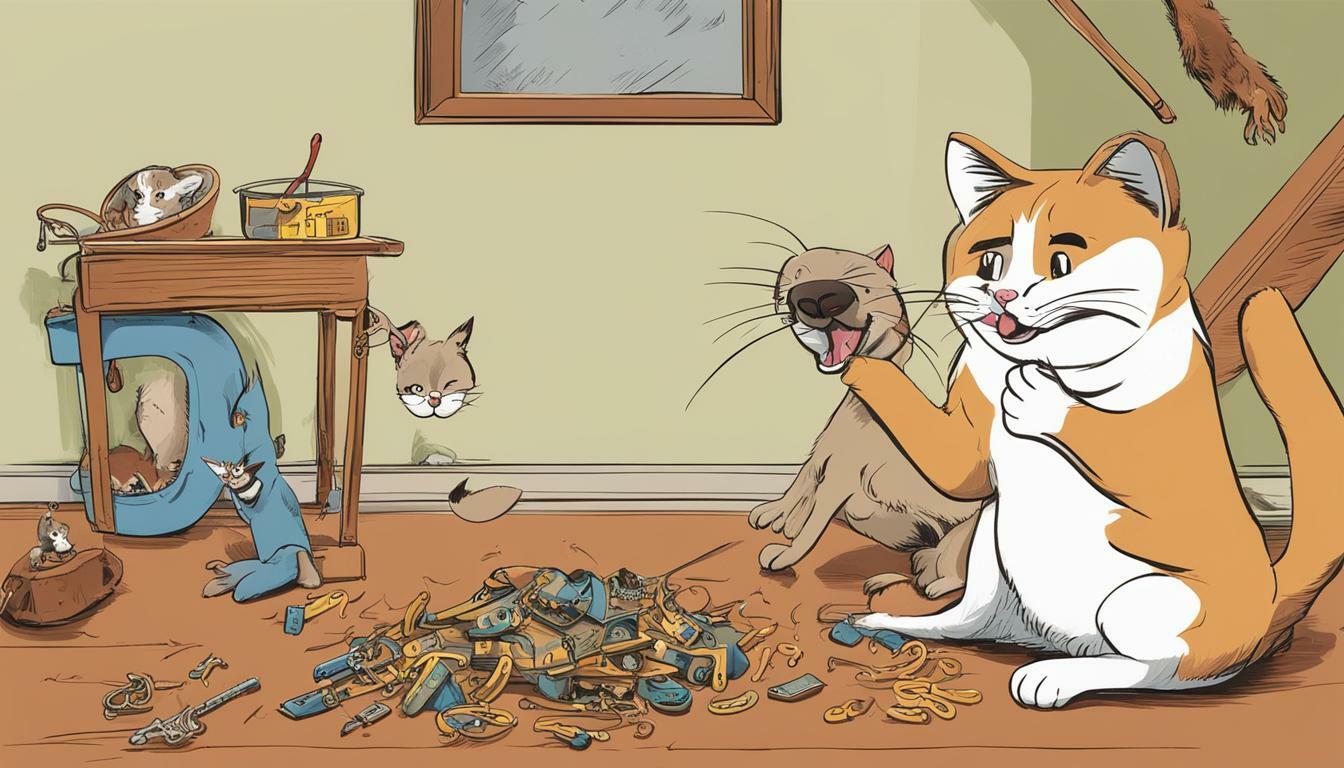
Being prepared for pet medical emergencies can make all the difference in ensuring the health and safety of your furry friend. In the next section, we will discuss the importance of having a pet emergency kit and the essential items that should be included.
The Importance of a Pet Emergency Kit
As a responsible pet owner, you want to ensure your furry friend is always safe and healthy. Accidents and emergencies can happen at any time, which is why having a well-stocked pet emergency kit is crucial. The right kit can mean the difference between life and death for your pet.
When creating a pet emergency kit, it’s essential to include the necessary animal first aid supplies. These supplies should be easily accessible and organized in a portable container, such as a waterproof bag or plastic container. Here are some of the pet safety essentials that should be included in your pet emergency kit:
| Item | Purpose |
|---|---|
| Gauze pads and rolls | To stop bleeding and cover wounds |
| Adhesive tape | To secure dressings and bandages |
| Scissors | To cut dressings and bandages |
| Hydrogen peroxide | To clean wounds and induce vomiting in case of poisoning (use only under veterinary guidance) |
| Antiseptic solution or wipes | To clean and disinfect wounds |
| Instant ice pack | To reduce swelling of sprains and burns |
| Tweezers | To remove ticks, thorns, or splinters from fur or skin |
| Latex gloves | To avoid infection and prevent the transmission of diseases |
| Medications | If your pet requires specific medication or has a chronic condition, talk to your veterinarian about including medication in your pet emergency kit. Ensure that all medication is in-date and has not passed its expiration date |
It’s important to remember that the contents of your pet emergency kit may vary depending on your pet’s breed, size, and medical history. Consult your veterinarian for additional guidance on what you should include.
Having a well-stocked pet emergency kit is crucial in providing immediate care for your pet during an emergency. Keep your kit in an easily accessible location in case of an emergency. Ensure all the supplies in your kit are in-date, and replace any expired or used items promptly. With a well-maintained kit and knowledge of administering first aid, pet owners can be confident they are doing everything they can to keep their pets safe and healthy.
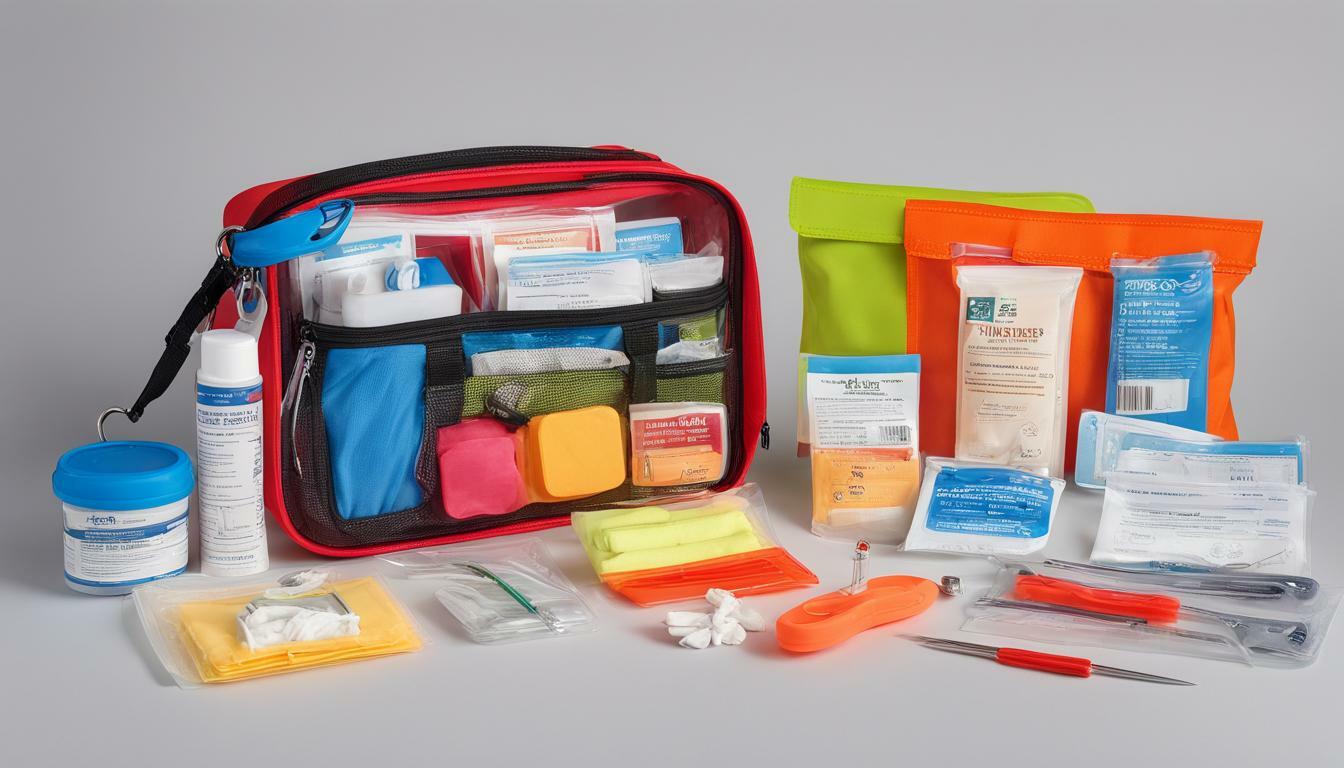
Choosing the Right First Aid Kit for Your Pet
Investing in a first aid kit for your pet is essential for their safety and well-being. However, choosing the right kit can be overwhelming with so many options available. It’s important to select a kit that includes the necessary pet first aid essentials and pet healthcare essentials. Here are some key components you should look for when choosing a first aid kit for your pet:
| Component | Purpose |
|---|---|
| Gauze pads and rolls | For wrapping wounds and controlling bleeding. |
| Adhesive tape | For securing bandages and wrapping wounds. |
| Scissors | For cutting bandages, gauze, and tape to the appropriate size. |
| Hydrogen peroxide | For cleaning wounds and inducing vomiting in case of poisoning (only under the guidance of a veterinarian). |
| Antiseptic wipes or solutions | For cleaning wounds and preventing infection. |
| Instant ice pack | For reducing swelling and controlling inflammation. |
| Tweezers | For removing splinters or other foreign objects from wounds. |
| Disposable gloves | For protecting yourself from bodily fluids and preventing infection. |
| Medication | Include any necessary medication prescribed by your veterinarian, such as pain relievers or antibiotics. |
It’s also essential to consider the size and weight of your pet when selecting a first aid kit. A small kit may be suitable for cats or small dogs, while larger dogs may require a more extensive kit.
Some reputable brands that offer quality first aid kits for pet owners include Pet First Aid, Adventure Medical Kits, and Red Cross. By investing in a reliable kit, you can have peace of mind knowing that you have the necessary tools to provide your pet with emergency care.
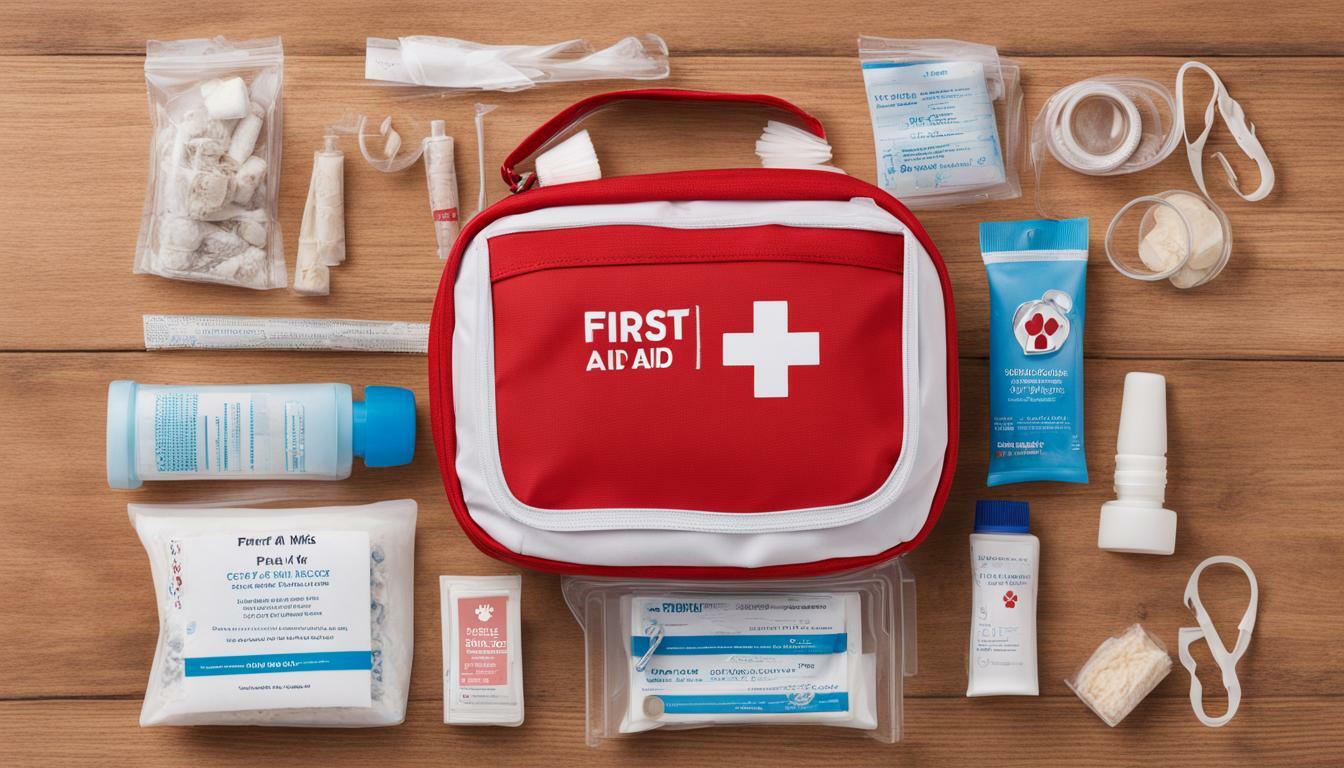
Remember to regularly check and restock your pet’s first aid kit to ensure that all items are up to date and ready to use in case of an emergency. With the right first aid kit for your pet, you can provide immediate care and potentially save your pet’s life.
Essential Items for Your Pet First Aid Kit
If you’re a pet owner, it’s essential to have a well-stocked first aid kit on hand in case of any emergencies. Here are some of the pet first aid essentials that should be included in your animal first aid supplies:
| Item | Function |
|---|---|
| Gauze pads | For cleaning and protecting wounds |
| Adhesive tape | To secure bandages and wraps |
| Scissors | To cut gauze, tape, and other materials |
| Hydrogen peroxide | To clean wounds and induce vomiting (only under veterinary guidance) |
| Tweezers | To remove ticks and other debris from your pet’s fur |
| Instant cold pack | To reduce swelling and pain |
| Disposable gloves | To protect yourself and your pet from infectious diseases |
| Antiseptic wipes | To clean and disinfect wounds |
| Medications | If your pet is on any medication, make sure to include a sufficient supply in your first aid kit |
It’s important to note that the above items are just a few inclusions that should be added to your pet’s first aid kit. Depending on your pet’s needs, you may need to add additional items, such as a thermometer, saline eye solution, a muzzle, or a pet carrier.
Remember to check your first aid kit regularly to ensure all supplies are up-to-date and in good condition. If any of your supplies are expired or damaged, dispose of them immediately and replace them with fresh ones.
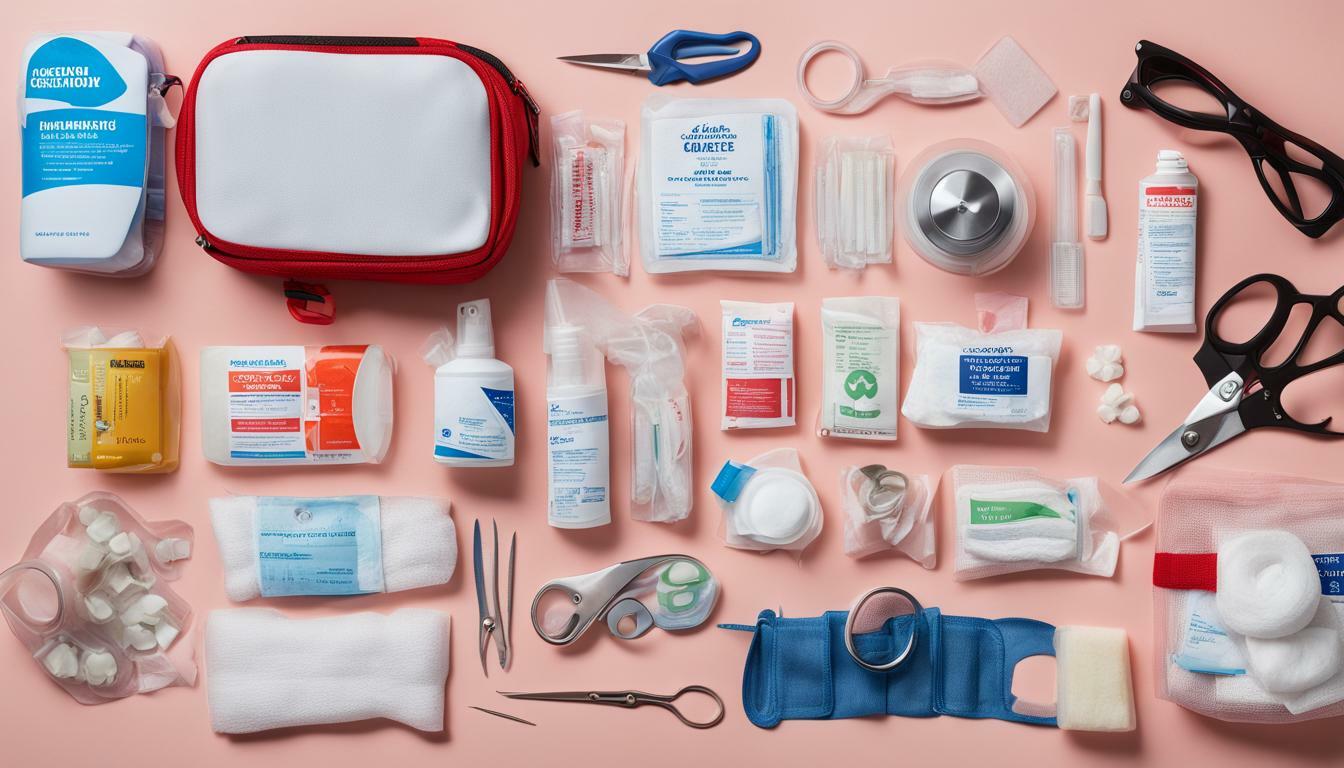
By keeping a well-stocked pet first aid kit on hand with these essential items, you’ll be equipped to handle any common animal emergencies that may arise.
Administering First Aid to Your Pet
Administering first aid to your pet is vital in emergency situations. Knowing how to act quickly and effectively can make all the difference in their recovery. Here, we provide step-by-step instructions on how to handle various common animal emergencies.
Choking
If your pet is choking, it’s important to act quickly. Start by opening their mouth and checking for any visible obstructions. If you can see the blockage, try to remove it using a pair of tweezers. If the blockage is not visible, perform the Heimlich manoeuvre by placing your hands just below their ribcage and applying pressure. If the pet remains choking, seek emergency care for pets immediately.
Wounds and Bleeding
For wounds or bleeding, begin by applying pressure to the affected area using a clean cloth or gauze. If the bleeding does not stop, use a tourniquet. Clean the wound with an antiseptic solution and cover it with a sterile dressing. Seek emergency care if the wound is deep, infected, or large.
Burns
For burns, start by flushing the affected area with cool water for several minutes. Then, cover the burnt area with a clean cloth. Do not use ice or butter. Seek emergency care for pets if the burn appears severe.
Poisoning
If you suspect your pet has ingested something toxic, call emergency services or your local veterinarian immediately. Bring the packaging of the toxic substance with you for reference. If advised, induce vomiting with hydrogen peroxide. Never induce vomiting without consulting with a professional first.
Fractures
For fractures, stabilize the affected area with a makeshift splint, using a rolled-up magazine or cardboard. Try to keep your pet still and seek emergency care for pets immediately.
Remember, administering first aid is only meant to provide immediate care until professional help is available. For any emergency situation, it is always best to consult with your trusted veterinarian or emergency care provider.

When to Seek Professional Help
As a pet owner, you may encounter a medical emergency that requires professional assistance. It’s essential to know when to seek veterinary care for your furry friend.
Pet medical emergencies can range from minor injuries to life-threatening conditions. If you notice any of the following symptoms, it’s crucial to seek emergency care for your pet:
- Breathing difficulties or choking
- Seizures or collapse
- Severe bleeding or injuries
- Difficulty walking or standing
- Persistent vomiting or diarrhea
- Swallowing of toxic substances or foreign objects
If you’re unsure whether your pet requires emergency care, contact a veterinary professional for advice. Do not attempt to provide medical treatment without professional guidance, as this could potentially worsen the situation.
Remember, seeking prompt veterinary care for your pet’s medical emergency can significantly improve their chances of recovery, so don’t delay in seeking professional help if needed.
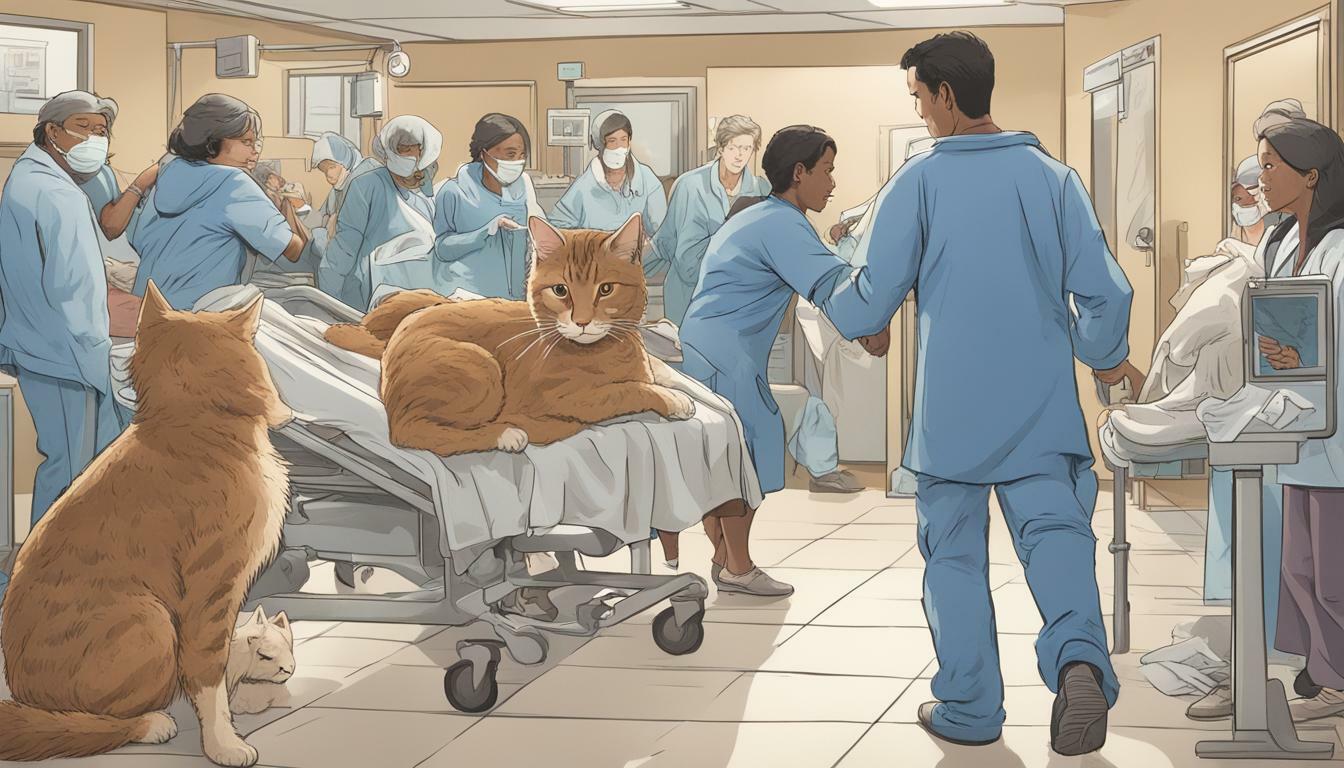
Pet Safety Essentials: Keeping Your Fur Baby Safe
As a responsible pet owner, it is essential to take the necessary steps to ensure your pet’s safety. A safe environment, a well-stocked pet first aid kit, and regular veterinary care are crucial in addressing common animal emergencies. Here are some pet safety essentials to keep in mind:
- Pet-proofing your home: Secure all toxic products, sharp objects, and potentially harmful items out of your pet’s reach. Keep electrical cords hidden or out of their reach, and ensure all doors and windows have secure locks. Consider installing baby gates to restrict access to certain areas.
- Using pet-friendly products: Choose pet-friendly cleaning products, insecticides, and other household items. Avoid using products that contain harmful chemicals that can harm your pet’s health. Always read the labels before purchasing any product.
- Providing a safe environment: Ensure your pet has a safe, comfortable space to rest and play. Keep them on a leash or in a fenced area when outside. Always supervise your pet’s interactions with other animals and people.
By implementing these measures, you can significantly reduce the risk of accidents and injuries to your furry friend.

Remember, prevention is key when it comes to pet safety. Taking the necessary precautions, investing in a pet first aid kit, and staying up to date with veterinary care can help you avoid common pet emergencies. Stay tuned for our next section, where we will discuss the importance of regular pet health check-ups and vaccinations.
Regular Pet Health Check-ups
Regular pet health check-ups are crucial in maintaining your furry friend’s overall well-being. Just like humans, pets need routine visits to the vet to ensure that they are healthy and happy. At these check-ups, a veterinarian will perform a physical examination and may recommend vaccinations or additional tests if needed.
Preventive measures such as vaccinations, flea, and tick treatments are essential for keeping your pet safe from harmful illnesses and parasites. During the visit, it is also an excellent opportunity for pet owners to discuss any concerns they may have with the vet, such as changes in behavior or diet.
By staying proactive in their pet’s healthcare, owners can minimize the likelihood of emergencies arising. A pet that is up-to-date on vaccinations and receives regular check-ups is less prone to illness and more likely to live a long and healthy life.
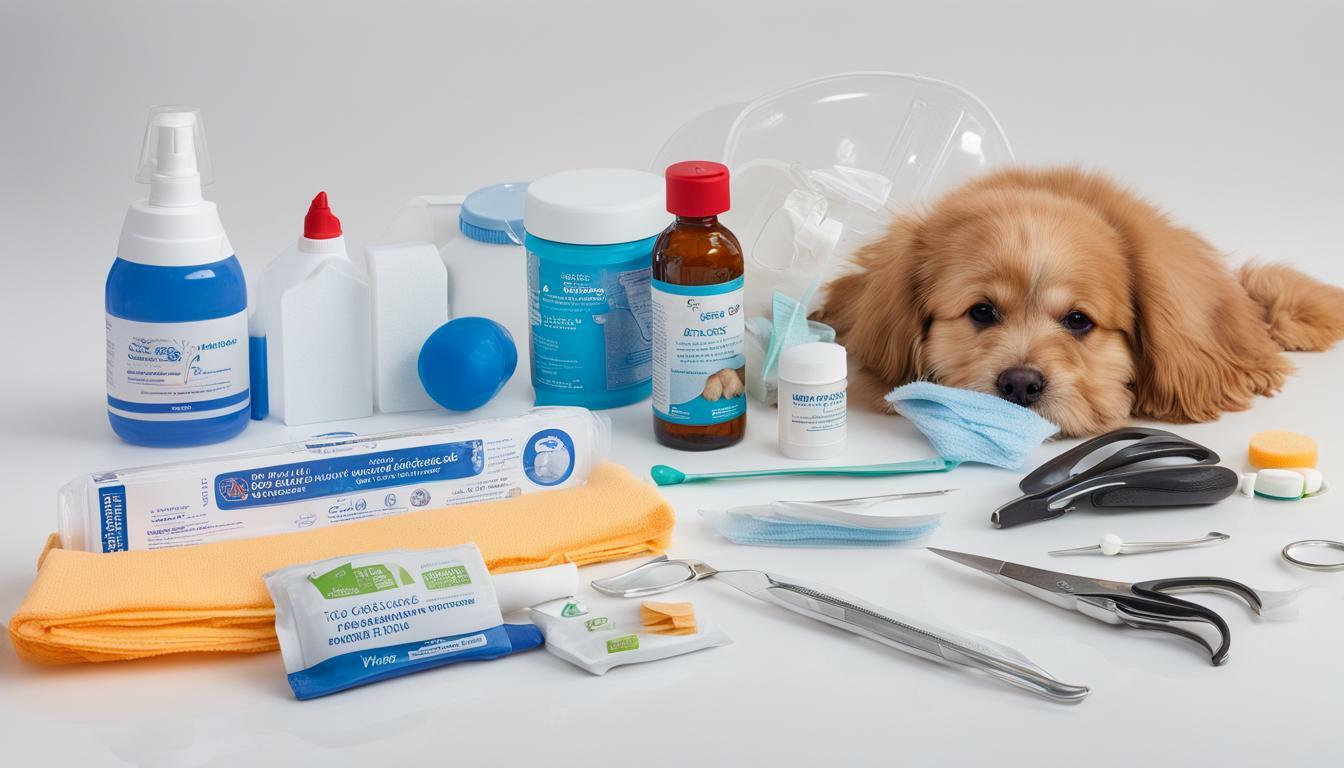
Don’t neglect your pet’s healthcare needs. Schedule regular check-ups with your veterinarian and stay on top of their vaccinations and preventive treatments. By prioritizing their health, you can give your pet the best chance for a happy and healthy life.
Educating Yourself on Pet First Aid
As a responsible pet owner, it’s essential to educate yourself on pet first aid essentials. By understanding common animal emergencies and how to provide effective care, you can help ensure your pet’s safety and well-being.
There are various resources available to help you learn pet first aid. Online courses, books, and local workshops can provide you with the necessary knowledge and skills to handle emergencies confidently. By taking the initiative to educate yourself, you can be better prepared for any situation that may arise.
Some of the common animal emergencies that every pet owner should be familiar with include choking, wounds, burns, and poisoning. Knowing how to recognize the signs and symptoms of these emergencies can help you act quickly and appropriately. Additionally, understanding how to administer first aid, such as performing CPR or stopping bleeding, can make all the difference in an emergency situation.
By staying informed and prepared, you can provide your pet with the best possible care. Make sure to keep your pet’s first aid kit well-stocked with essential supplies, such as gauze pads, adhesive tape, scissors, and hydrogen peroxide. Regularly check and replace expired items to ensure that you are always prepared for emergencies.
Remember, pet first aid is an essential part of being a responsible pet owner. By educating yourself and staying prepared, you can ensure your pet’s health and safety in any situation.
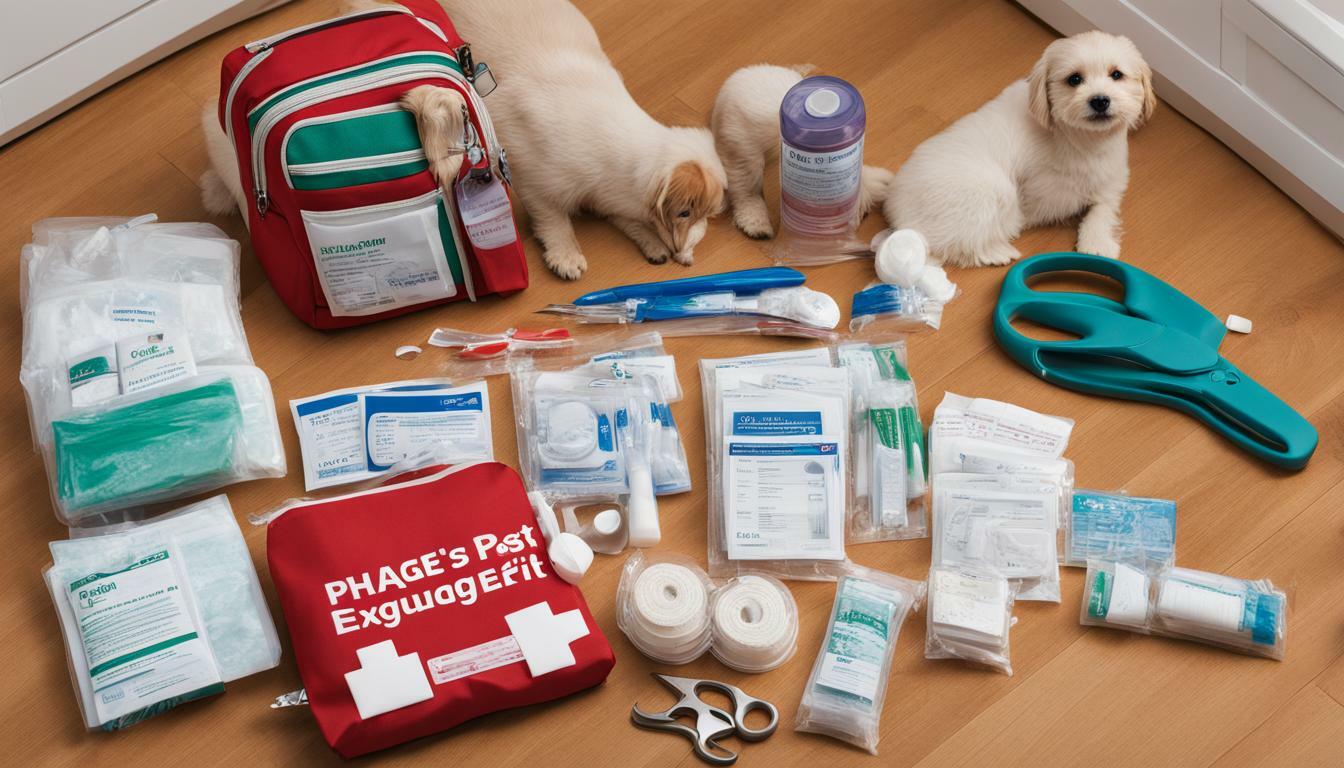
Pet First Aid Kit Maintenance
Proper maintenance of your pet’s first aid kit is crucial to ensure that the supplies are ready to use when needed. Regularly checking and restocking your kit will give you peace of mind knowing that you are prepared for any emergency. Here are some tips for maintaining your pet first aid kit:
| Task | Frequency |
|---|---|
| Check expiration dates on all items | Monthly |
| Replace expired items | Immediately |
| Restock essential supplies | As needed |
| Keep a list of kit contents | Ongoing |
| Maintain a well-organized kit | Ongoing |
It’s important to keep a list of the contents of your pet first aid kit to make it easier to restock and replace items. Keep the list in a visible place near the kit, along with any emergency phone numbers, including your veterinarian’s contact details.
A well-organized kit allows you to quickly locate items in an emergency. Keep items in clearly labeled, waterproof containers, and ensure that everyone in the family knows where the kit is stored. Consider adding an identifying name tag for your pet to the outside of the kit for added visibility.
By maintaining your pet first aid kit, you can be confident that you are prepared for any emergency. Keeping your kit up-to-date with essential animal first aid supplies is a crucial part of maintaining your pet’s health and safety.
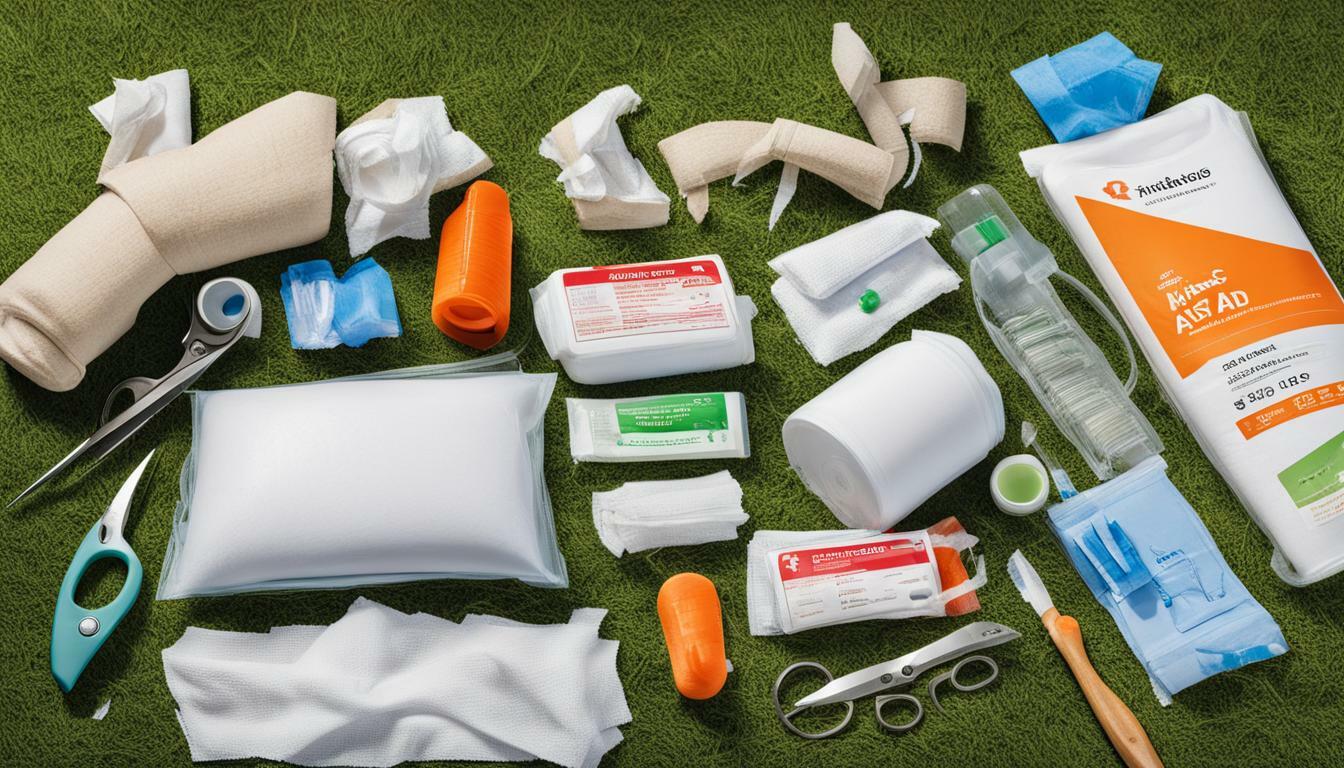
The Importance of a Pet Emergency Kit
As a responsible pet owner, it’s essential to be prepared for any emergency that may arise. A pet emergency kit is a vital tool that can help you address common animal emergencies promptly. When putting together your kit, it’s important to consider what items are essential for your pet’s safety.
Animal First Aid Supplies
One of the key components of a pet emergency kit is animal first aid supplies. These include items such as gauze pads, adhesive tape, scissors, and hydrogen peroxide. It’s important to ensure that you have a sufficient quantity of these supplies to address any emergency that may arise.
Pet Medication
If your pet has any pre-existing medical conditions, you should include their medication in their emergency kit. This will ensure that you have the necessary supplies to address their needs in case of an emergency. Make sure to check the expiry date of the medication regularly and replace it as needed.
Emergency Contacts
Another essential item to include in your pet emergency kit is a list of emergency contacts. This should include your veterinarian’s phone number, the number for a local emergency veterinary clinic, and a trusted friend or family member who can assist you in case of an emergency.
Proper Storage
It’s important to store your pet emergency kit in a cool, dry place that is easily accessible in case of an emergency. Make sure to check the kit regularly and replace any expired items. An organized kit will help you quickly identify and access the necessary supplies when needed.
A well-stocked and maintained pet emergency kit can be a lifesaver in an emergency situation. By including essential items such as animal first aid supplies, pet medication, and emergency contacts, you can ensure your pet’s safety and well-being. Remember to regularly check and maintain your kit to ensure that it’s always ready for any emergency that may arise.
